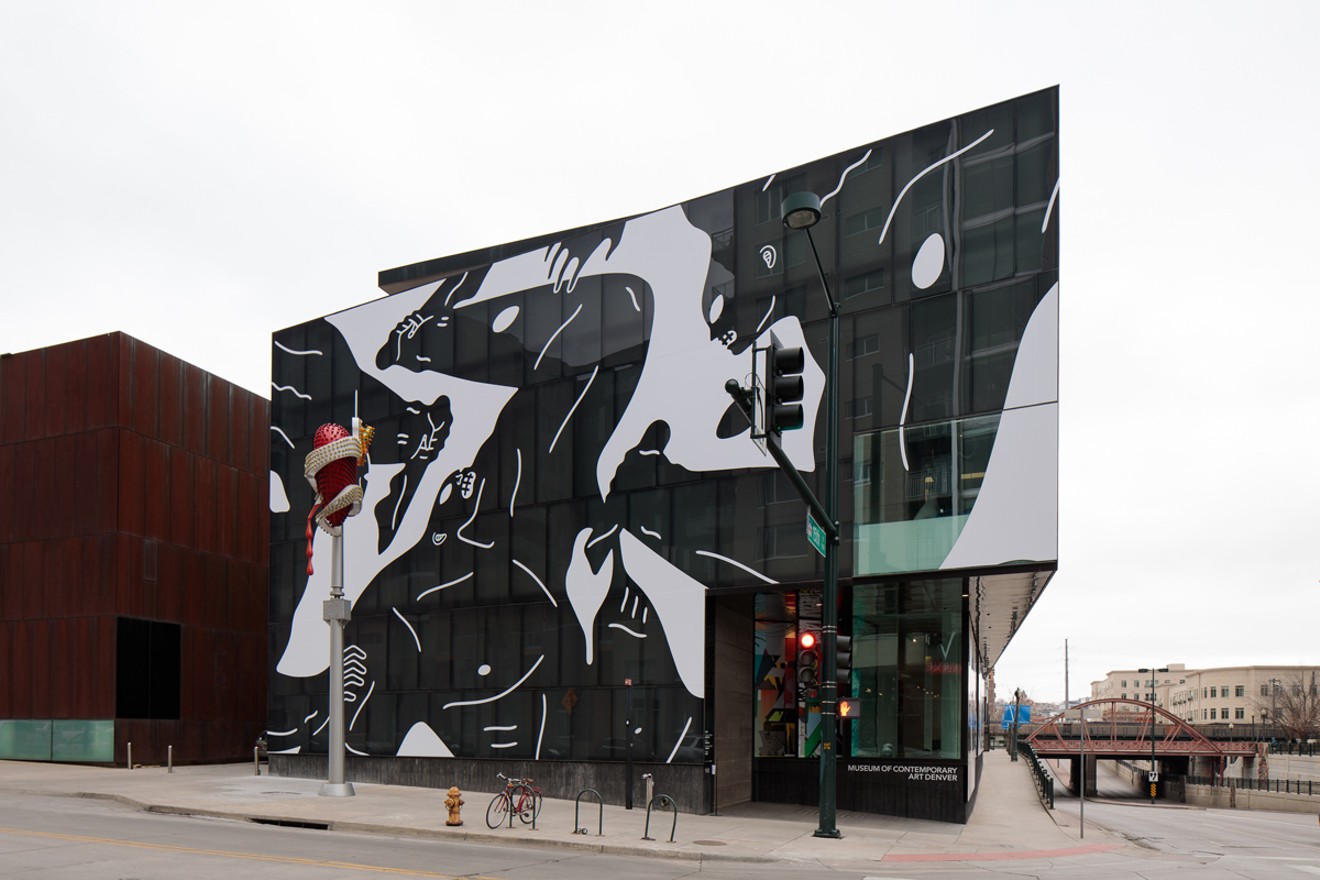Cleon Peterson: Shadow of Men is certainly powerful enough to fill the museum, though the paintings and sculptures are limited to the upper floor. The solo was curated by MCA director Adam Lerner, and when I walked through it with him, we were joined by Peterson, who was at the museum to autograph books. Peterson is based in Los Angeles but grew up in Seattle, where he began creating art as a boy. From the start, he had a taste for portraying armed conflict, and he was especially interested in battles from the Second World War. His mother encouraged him; he recalls that she gave him a book about the Fauves and urged him to create still-life paintings. He had great success with that type of work as a child, when he exhibited and was hailed as a prodigy. Derailed in his late teens by a life that included drugs and some jail time — though even then he painted skateboards and did graffiti — Peterson eventually returned to a more formal approach to art and ultimately earned an MFA from Cranbrook Academy.
For almost all of the paintings at the MCA, along with the exterior wrap and sculptures, Peterson has developed a shorthand vocabulary to convey men (and a few women) who are at deadly odds with each other, wielding knives, swords and even the occasional rifle. The aggressors are typically done in black and the victims in sand or white. Despite the obvious racial interpretation of the colors, Peterson says he didn’t intend that; instead, he sees the black figures as representing the dark heart within all people, including himself, that promotes violence. To underscore that darkness, Peterson has also created simple, natural shapes corresponding to wounds and pools of blood, but rather than doing them in red, he stays within the black/white/tan shades he’s limited himself to. In the paintings, these shapes are reduced to basic expressions and filled in with an extremely flat layer of paint, with tight margins between the colors, while in the sculptures the same effect is achieved through the smoothness of the surfaces and the softness of the forms.
There’s an undeniable classicism to Peterson’s work that makes you think of Ancient Greece. And that’s no accident, since the artist believes that violence has been associated with the Greco-Roman tradition right up to the Nazis, and he has long been fascinated by that negative undercurrent. Maybe those classical principles explain why Peterson’s figures can be effectively scaled up and down while still retaining their key characteristics: They work as well as tiny porcelain figurines as they do as monumental sculptures, not to mention building wraps.
In many ways, the pieces in the eye-popping Diego Rodriguez-Warner: Honestly Lying are the polar opposite of the Petersons. Rodriguez-Warner’s complex forms contrast with Peterson’s reductive handling of the figure. There’s a big divergence in palette, too, with Rodriguez-Warner’s riot of toned-up shades creating a striking juxtaposition to Peterson’s quiet hues.
Born in Nicaragua, Rodriguez-Warner grew up in Denver but pursued his art education elsewhere, studying in Cuba and receiving his MFA from the Rhode Island School of Design. The young artist is on a decidedly upward trajectory, as shown by this solo curated by Zoe Larkins. It starts off with a bang: a riot of colors and images on the entry wall, which is hung salon style and crammed with visually emphatic paintings. Rodriguez-Warner comes out of the printmaking tradition, and you can see that in the paintings. He’s taken the carving of wood blocks used for prints and translated that into a compositional element by making shallow carvings in the surfaces of the plywood panels on which he paints.
Looking over the dizzying mass of images assembled by Rodriguez-Warner, you begin to recognize that many of them come from the history of art, with sources ranging from Japanese prints to Matisse. Also reflecting art history is the way in which many of these pieces seem to be parodying old paintings, in particular history paintings. But according to Larkins, the specific historical sources were not particularly important to Rodriguez-Warner, who chose the images based purely on their visual appeal. To help viewers understand the artist’s picture-making process, Larkins set up a showcase with scores of tiny images pinned to a foam board.
The way that Rodriguez-Warner uses the formal elements, which include recognizable bits here and there, lend the paintings a pop-surrealist character, with suggestions of distorted figures as well as disembodied feet and hands. But the results aren’t as creepy as you might imagine; in fact, they’re downright spectacular. With this show, Rodriguez-Warner enters the top ranks of Denver artists.

"Love is the Message, The Message is Death" still from Arthur Jaka video.
Courtesy Arthur Jafa and Gavin Brown's enterprise, New York/ Rome
Jafa has said that his piece is not specifically about the Black Lives Matter movement, but that theme resonates throughout this amazing work. I can’t remember the last time I wasn’t bored by a video, but Jafa’s engaged me all the way through. I could have watched it again.
Peterson, Rodriguez-Warner and Jafa cover a lot of conceptual and aesthetic ground, but they have one thing in common: Each has a knockout solo at MCA Denver.
Cleon Peterson, through May 27; Diego Rodriguez-Warner and Arthur Jafa, through May 13, both at MCA Denver, 1485 Delgany Street. There will be an artist talk at the museumwith Diego Rodriguez-Warner and MCA assistant curator Zoe Larkins at 7 p.m. Thursday, February 22; tickets are $5 to $10. Find more information at 303-298-7554 or mcadenver.org.














